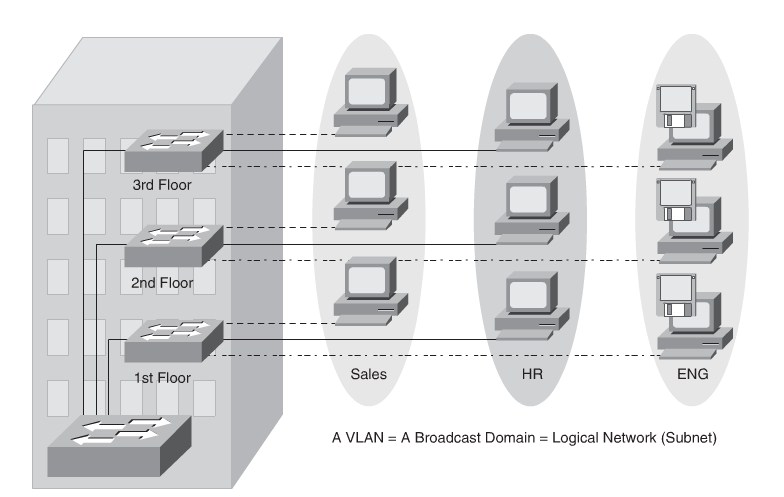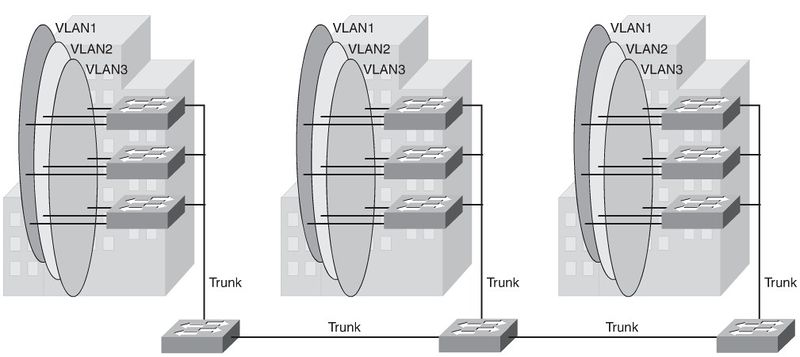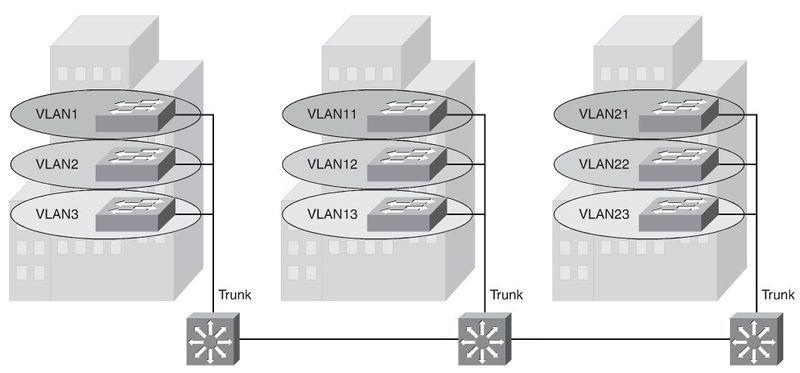Difference between revisions of "CCNP SWITCH/Implementing VLANs in Campus Networks"
m (Created page with "{{In progress}}") |
m |
||
| Line 1: | Line 1: | ||
{{In progress}} | {{In progress}} | ||
| + | =VLANs= | ||
| + | ==VLAN definition== | ||
| + | {| | ||
| + | |[[Image:ScreenShot1074.jpg|800px|left|thumb|VLAN Definition]] | ||
| + | |} | ||
| + | Trunking: | ||
| + | *ISL(Is not a part of this exam) | ||
| + | *802.1Q(The Industry standard) | ||
| + | ==End-To-End VLANs== | ||
| + | {| | ||
| + | |[[Image:ScreenShot1075.jpg|800px|left|thumb|End-To-End VLANs]] | ||
| + | |} | ||
| + | *Each VLAN is dispersed geographically throughout the network. | ||
| + | *Users are grouped into each VLAN regardless of the physical location. | ||
| + | *As a user moves throughout a campus, the VLAN membership of that user remains | ||
| + | the same, regardless of the physical switch to which this user attaches. | ||
| + | *Users are typically associated with a given VLAN for network management reasons. | ||
| + | This is why they are kept in the same VLAN, therefore the same group, as they move | ||
| + | through the campus. | ||
| + | *All devices on a given VLAN typically have addresses on the same IP subnet | ||
| + | ==Local VLANs== | ||
| + | {| | ||
| + | |[[Image:ScreenShot1076.jpg|800px|left|thumb|Local VLANs]] | ||
| + | |} | ||
| + | *The network administrator should create local VLANs with physical boundaries in | ||
| + | mind rather than the job functions of the users on the end devices. | ||
| + | *Generally, local VLANs exist between the access and distribution levels. | ||
| + | *Traffic from a local VLAN is routed at the distribution and core levels to reach desti- | ||
| + | nations on other networks. | ||
| + | *Configure the VTP mode in transparent mode because VLANs on a given access | ||
| + | switch should not be advertised to all other switches in the network, nor do they | ||
| + | need to be manually created in any other switch’s VLAN database. | ||
| + | *A network that consists entirely of local VLANs can benefit from increased conver- | ||
| + | gence times offered via routing protocols, instead of a spanning tree for Layer 2 net- | ||
| + | works. It is usually recommended to have one to three VLANs per access layer | ||
| + | switches. | ||
| + | ==Comparison of End-to-End VLANs and Local VLANs== | ||
| + | *'''Grouping users''':Users can be grouped on a common IP segment, even though they | ||
| + | are geographically dispersed. Recently the trend has been moving toward virtualiza- | ||
| + | tion. Solutions such as VMWARE need end-to-end VLANs to be spread across seg- | ||
| + | ments of the campus. | ||
| + | *'''Applying quality of service (QoS)''':Traffic can be a higher or lower access priority | ||
| + | to network resources from a given VLAN. | ||
| + | *'''Routing avoidance''':If much of the VLAN user traffic is destined for devices on that | ||
| + | same VLAN, and routing to those devices is not desirable, users can access | ||
| + | resources on their VLAN without their traffic being routed off the VLAN, even | ||
| + | though the traffic might traverse multiple switches. | ||
Revision as of 19:40, 22 August 2011
VLANs
VLAN definition
Trunking:
- ISL(Is not a part of this exam)
- 802.1Q(The Industry standard)
End-To-End VLANs
- Each VLAN is dispersed geographically throughout the network.
- Users are grouped into each VLAN regardless of the physical location.
- As a user moves throughout a campus, the VLAN membership of that user remains
the same, regardless of the physical switch to which this user attaches.
- Users are typically associated with a given VLAN for network management reasons.
This is why they are kept in the same VLAN, therefore the same group, as they move through the campus.
- All devices on a given VLAN typically have addresses on the same IP subnet
Local VLANs
- The network administrator should create local VLANs with physical boundaries in
mind rather than the job functions of the users on the end devices.
- Generally, local VLANs exist between the access and distribution levels.
- Traffic from a local VLAN is routed at the distribution and core levels to reach desti-
nations on other networks.
- Configure the VTP mode in transparent mode because VLANs on a given access
switch should not be advertised to all other switches in the network, nor do they need to be manually created in any other switch’s VLAN database.
- A network that consists entirely of local VLANs can benefit from increased conver-
gence times offered via routing protocols, instead of a spanning tree for Layer 2 net- works. It is usually recommended to have one to three VLANs per access layer switches.
Comparison of End-to-End VLANs and Local VLANs
- Grouping users:Users can be grouped on a common IP segment, even though they
are geographically dispersed. Recently the trend has been moving toward virtualiza- tion. Solutions such as VMWARE need end-to-end VLANs to be spread across seg- ments of the campus.
- Applying quality of service (QoS):Traffic can be a higher or lower access priority
to network resources from a given VLAN.
- Routing avoidance:If much of the VLAN user traffic is destined for devices on that
same VLAN, and routing to those devices is not desirable, users can access resources on their VLAN without their traffic being routed off the VLAN, even though the traffic might traverse multiple switches.
 This article is under development....
This article is under development....

